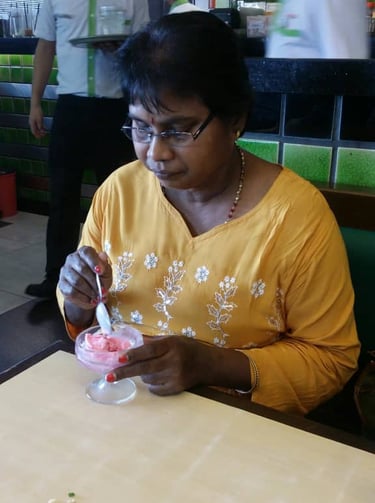Goodbye, Amma: A Story of Death, Culture, and What Comes After
HINDU NATIONCOMMUNITYFEATURED


Guilty Pleasure: Amma ,enjoying her Ice Cream, despite being a diabetic
Part 1: Death – The Beginning of the End
Two years ago, my mother passed away.
She had cancer. We knew it was terminal. We had time to prepare—or so we thought. Emotionally, we braced ourselves for the inevitable. But when death finally came, it was like stepping into a storm without knowing how to swim. No amount of mental preparation could ready us for the physical, spiritual, and cultural weight of what followed.
We are a Hindu family. My mother, Mary —yes, she was a baptized Catholic. But faith, like life, isn’t always linear. Though she carried her Catholic name and roots, she lived as a practicing Hindu. Her rituals, her prayers, her way of being—it was deeply woven into our family’s rhythm. When the time came to say goodbye, we chose to honor her through Hindu rites. Not out of religious rigidity or obligation, but because it felt right. It was familiar. It was what she embraced in her everyday life. And in those fragile moments when everything felt like it was unraveling, it was the one thing we could hold onto.
In the days that followed, I searched online for guidance. I wanted something practical—step-by-step instructions, locally relevant rituals, emotional checkpoints. But I found nothing that spoke to our experience. Nothing that felt human. Nothing that helped me navigate the chaos of grief, tradition, and logistics.
So I made a vow: once the rituals were done, once the dust settled, I would write it all down. Not as a guidebook. Not as gospel. But as a personal account—something raw, real, and maybe useful to someone else walking this path.
It’s taken me two years to come back to this. To find the words. To sit with the silence and turn it into something meaningful.
This will be a multipart series. It’s not perfect. It’s not universal. It’s simply what I did. What we did. What felt right in the moment. If you’re reading this because you’ve lost someone, or you’re preparing to, I hope this helps you feel a little less alone.
Let’s begin with death.
Part 2: The First Question – Where Do You Bring the Body?
No one prepares you for this question. It comes fast, often within minutes or hours of death. And it’s jarring.
Where do you want to bring the body?
It sounds clinical. But it’s the first decision that sets everything else in motion. And in that moment, you're not thinking clearly. You're grieving. You're in shock. Yet you have to choose.
Option 1: The Funeral Parlour
If you live in a condo, this is often the most practical choice. Funeral parlours handle everything—the body, the rituals, the logistics. You just need to bring your loved one there and choose a package. It’s less personal, yes. Call me old-fashioned, but I struggled with that. Still, it’s less of a headache.
You get to focus on what truly matters: saying goodbye. Not worrying about cleaning the house, managing guests, or coordinating ceremonies. Trust me, the logistics can get overwhelming fast. The parlour buffers you from that chaos.
Option 2: Bring Them Home
Some condos do allow you to use the hall, but it’s rarely straightforward. Visitor parking, security checks, access restrictions—it all adds up. And when you're grieving, even the smallest logistical hurdle can feel like a mountain.
If you live in a landed property, the experience shifts. Personally, I believe there’s something deeply meaningful about bringing your loved one back to where they lived. The walls remember. The neighbors remember. There’s comfort in the familiar, and often, help too. While there’s a sentimental weight to it, yes—but also a very real need for support. You can’t light the stove, so kids cant be fed. You’ll be juggling rituals, guests, and raw grief. In moments like that, good neighbors aren’t just helpful—they’re essential.
This is what we chose, we brought her back to my place. The place she said she wanted to come to after she got out of the hospital. She didn’t live here—she had a flat so it was not practical to do it there—but this was my home, the next best thing and more importantly, it was where she spent her final days. So it felt right. Not just emotionally, but practically.
